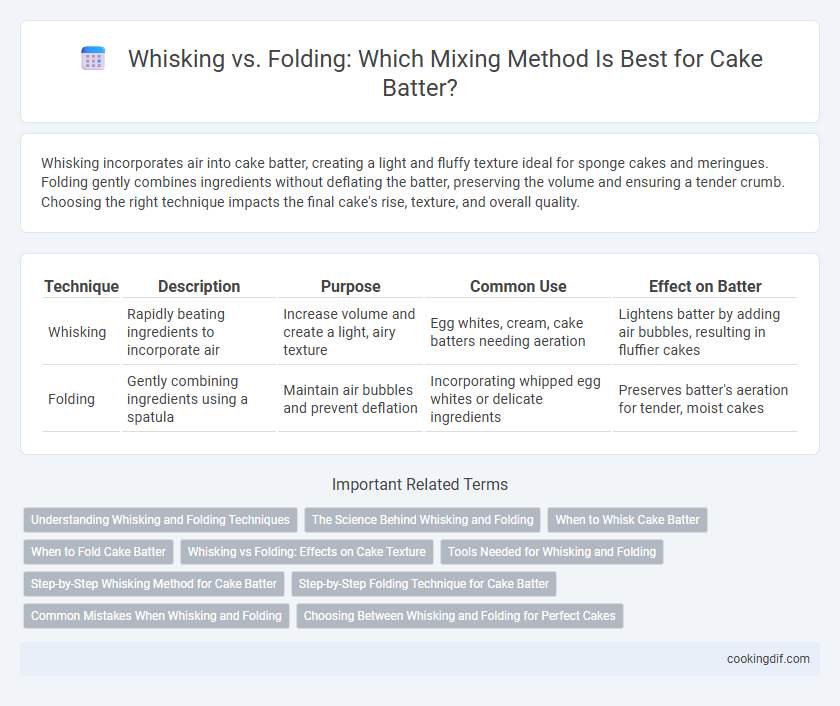Whisking incorporates air into cake batter, creating a light and fluffy texture ideal for sponge cakes and meringues. Folding gently combines ingredients without deflating the batter, preserving the volume and ensuring a tender crumb. Choosing the right technique impacts the final cake's rise, texture, and overall quality.
Table of Comparison
| Technique | Description | Purpose | Common Use | Effect on Batter |
|---|---|---|---|---|
| Whisking | Rapidly beating ingredients to incorporate air | Increase volume and create a light, airy texture | Egg whites, cream, cake batters needing aeration | Lightens batter by adding air bubbles, resulting in fluffier cakes |
| Folding | Gently combining ingredients using a spatula | Maintain air bubbles and prevent deflation | Incorporating whipped egg whites or delicate ingredients | Preserves batter's aeration for tender, moist cakes |
Understanding Whisking and Folding Techniques
Whisking incorporates air into the batter by vigorously beating ingredients, creating a light and fluffy texture essential for sponge cakes and meringues. Folding gently combines delicate ingredients, such as whipped egg whites or whipped cream, without deflating the air bubbles vital for volume and softness. Mastering the distinction between whisking and folding techniques ensures optimal batter consistency and results in a cake with the desired crumb and rise.
The Science Behind Whisking and Folding
Whisking incorporates air into the batter by rapidly beating ingredients, creating a light and airy texture essential for sponge cakes and mousses. Folding, on the other hand, gently combines ingredients without deflating the trapped air, preserving the batter's volume and delicate structure. Understanding the molecular interaction between proteins and air bubbles during whisking and the careful manipulation during folding ensures optimal rise and texture in baked cakes.
When to Whisk Cake Batter
Whisking cake batter is essential when incorporating air into light and fluffy cakes like sponge or chiffon to achieve a delicate crumb texture. It is most effective during the initial stages of mixing eggs and sugar, as the whisk rapidly aerates and emulsifies these ingredients for maximum volume. Avoid whisking dense batters to prevent overmixing, which can lead to toughness in the final cake.
When to Fold Cake Batter
Fold cake batter when incorporating delicate ingredients like whipped egg whites or whipped cream to maintain airiness and volume. Whisking works best for combining wet and dry ingredients until smooth, but folding preserves the batter's light texture by gently blending without deflating. Overmixing cream-based or sponge cake batters can lead to dense, tough cakes, making folding essential for optimal fluffiness.
Whisking vs Folding: Effects on Cake Texture
Whisking incorporates air into the batter, creating a light and airy texture ideal for sponge cakes, while folding gently combines ingredients to maintain air bubbles, preserving a tender crumb in delicate cakes such as chiffon or angel food. Over-whisking can cause the batter to collapse, resulting in a dense cake, whereas improper folding can lead to uneven texture due to deflated batter. Selecting the appropriate technique influences the cake's final volume, crumb softness, and overall texture quality.
Tools Needed for Whisking and Folding
Whisking requires a balloon whisk or electric mixer to incorporate air and achieve a light, fluffy batter consistency. Folding uses a rubber spatula or large metal spoon to gently combine ingredients without deflating the batter, preserving its volume. Choosing the appropriate tool ensures optimal texture and structure in cake batter preparation.
Step-by-Step Whisking Method for Cake Batter
Whisking cake batter involves rapidly beating air into the mixture, creating a light and fluffy texture essential for cakes like sponge or chiffon. Begin by combining eggs and sugar, whisk vigorously until the mixture is pale and forms soft peaks, then gradually fold in the dry ingredients without deflating the aerated batter. This step-by-step whisking method ensures a well-incorporated, airy batter that contributes to a tender crumb and optimal rise during baking.
Step-by-Step Folding Technique for Cake Batter
Whisking incorporates air into cake batter by vigorously mixing ingredients, creating a light texture, while folding gently combines delicate components like whipped egg whites without deflating them. The step-by-step folding technique involves using a spatula to cut through the center of the batter, sweeping along the bowl's edge, and turning the bowl gradually to maintain volume. This method ensures even mixing and prevents loss of air, resulting in a tender, airy cake crumb.
Common Mistakes When Whisking and Folding
Whisking batter too vigorously can incorporate excess air, resulting in a dry, crumbly cake texture, while under-whisking may leave lumps and uneven mixing. Folding improperly by stirring instead of gently lifting the batter can deflate delicate air bubbles, causing a dense, flat cake. Common mistakes include using the wrong technique for the recipe's needs, which affects rise, texture, and crumb structure in the final cake.
Choosing Between Whisking and Folding for Perfect Cakes
Whisking incorporates air quickly into batter, creating a light and fluffy texture ideal for sponge cakes and meringues. Folding gently combines ingredients without deflating the air bubbles, preserving volume in delicate mixtures like chiffon or angel food cakes. Selecting whisking or folding depends on the cake type and desired crumb structure to ensure optimal rise and moistness.
Whisking vs folding for batter mixing Infographic

 cookingdif.com
cookingdif.com